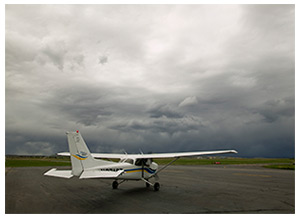Training Tips
|

Sierra, Tango, and Zulu
A student pilot flying a single-engine trainer at modest altitudes has different weather-information needs than a corporate pilot planning a trip in the flight levels. But before either aviator can plan a route or make a proper go/no-go decision, both need a macro view of the weather picture.
For the student pilot, the big questions about the weather may be answered during a preflight weather briefing's review of the current airmen's meteorological information (airmet) report.
An airmet "advises of weather that may be hazardous, other than convective activity, to single engine, other light aircraft, and Visual Flight Rule (VFR) pilots. However, operators of large aircraft may also be concerned with these phenomena," explains the National Weather Service. Airmet weather components are forecast to affect an area at least 3,000 square miles. Convective activity is the province of another weather product: the sigmet.
Airmet components include instrument meteorological conditions (airmet Sierra), turbulence (airmet Tango), and icing (airmet Zulu). The icing forecast also includes forecast freezing levels—of interest to VFR pilots because they must avoid potentially dangerous conditions such as freezing rain.
For the new pilot, most three-letter location identifiers used to describe airmet forecast areas won’t be readily recognizable. That's where graphic depictions help—or you should make the effort to check the forecast coverage area's boundaries on charts or in reference publications.
For example, pilots in the Northeast studying a WA (the airmet code) after early December storms saw airmet Tango's coverage "FROM 70NW PQI TO MLT TO 20W ENE TO HAR TO CSN TO 40SE PSK TO HMV TO HNN TO JHW TO SYR TO MSS TO YSC TO 70NW PQI."
The stormy weather was punctuating the six-hour airmet-issuance schedule with multiple updates: AIRMET TANGO UPDT 3 FOR TURB STG WNDS AND LLWS VALID UNTIL 102100.
"Once you're satisfied that none of a day's adverse conditions are expected along the route of the flight you're planning, you can go ahead and gather all of the other weather information needed for the flight without worrying too much about being surprised by bad news," advised meteorologist Jack Williams in Flight Training's "The Weather Never Sleeps."
"But, don't become too complacent. As anyone with much weather experience can tell you, the atmosphere springs surprises from time to time," he added.
|
|



